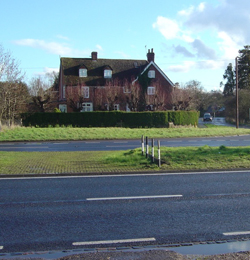M40 Junction 15 (Longbridge) Bypass |

85.9% |
Interim Client and Design Award
Project Team:
Client: Highways Agency
Contractor: Morrison Construction
Designer:
Hyder Consulting
The Project
The team designed a dual carriageway bypass of the M40 Junction 15, allowing vehicles travelling on the A46 to avoid this busy junction. The bypass will be routed to the west of the junction and connected to the existing A46, north and south of the motorway. The existing M40 Junction 15 roundabout will be widened to four lanes, the approaches to the roundabout will be improved, and new traffic lights installed. The signing, road markings, road lighting and road pavement will be updated to improve safety and driver understanding. A new 4-span bridge will be built to take the new dual carriageway over the M40 motorway.
The southern connection between the new dual carriageway and the A46 Stratford road will be a roundabout, which will also provide access to the B4463 and M40 Junction 15. The roundabout will include underpasses to allow the safe movement of farm vehicles and pedestrians, cyclists and equestrians under the A46.
 |
|
Ecology and Biodiversity
A large maternity bat roost was discovered in two ash trees adjacent to the M40 scheme footprint. The roost was one of only two large Noctule roosts known to English Nature (now Natural England), the other being near Cambridge. Due to the importance of the roost and the risk of disturbance from the scheme during both construction and operation, English Nature advised that they would formally object at Public Inquiry if the scheme were to go ahead unchanged. Following an extensive optioneering exercise, a revised scheme further east towards the village of Sherbourne was developed, which moved the proposed A46 bypass approximately 200m away from the roost.
In addition to the work on bats, ecological surveys were carried out in relation to flora, amphibians and other mammals. Advance works include plans for translocation of reptiles from existing highway verges to identified receptor sites nearby. The scheme design includes mammal mitigation to allow badgers and otters to cross the scheme via special underpasses and ledges within culverts.
 |
|
Archaeology
The scheme is situated on terraces of the River Avon and these terraces have proved rich in archaeology in the past. A number of discoveries have been made in this general area, including various crop marks and henge sites (now Scheduled Ancient Monuments). In order to address concerns from Warwickshire County Council that further significant archaeological remains might be disturbed by the scheme, a comprehensive scheme of geophysical surveys and trial trenching was carried out, both on land required for the scheme itself and proposed borrow pits. To date, however, nothing significant has been found.
Sustainable design
Sustainable drainage principles were adopted in the drainage system designs. Whereas drainage current flows directly into watercourses within the scheme area, run-off from the proposed scheme will be fed through a system of five storm-water wetlands. This will not only provide attenuation and reduce peak flows, but will also help to treat run-off and remove contamination. Although not their primary purpose, the ponds will also provide improved habitat diversity and feeding opportunities for other species.
Borrow pits have been identified adjacent to the scheme to provide the significant volume of fill material needed (in the order of 700,000m3). Planning permission for the borrow pits was obtained via a separate planning application. By obtaining the material locally, thousand of lorry movements will be avoided, bringing substantial benefits to local residents by minimising impacts on local air quality, noise and disruption during construction.
 |
|
Environmental and Community Liaison
The scheme has been developed in close co-operation with various statutory consultees including Natural England, the Environment Agency and the local authorities, Warwickshire County Council and Warwick District Council.
 |
|
Summary
An 'Excellent' CEEQUAL Interim Award has been achieved by careful consideration of environmental issues from the outset, as described above. With input from the Morrison team, the scheme has been designed to minimise environmental impacts and ensure that design of the final scheme is sustainable. The development of a Construction Environment Management Plan shows a commitment to long-term environmental management during construction and operation.
